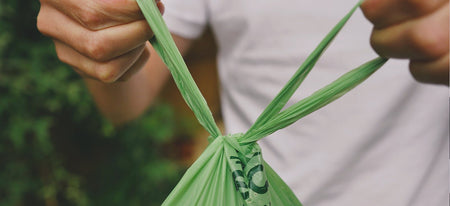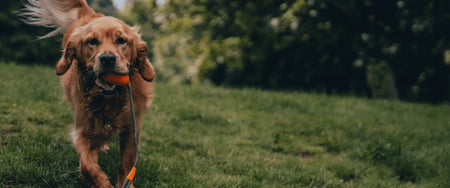
Dealing with dog poop may be one of the more unpleasant parts of being a dog owner.
But getting to know what is normal vs what isn’t in that department is really important, because healthy poop generally equals a healthy pup.
So, next time, before you rush to pop it in your doggy poop bag, take note! These doggy deposits offer a vital window into your beloved pooch’s digestive health and therefore their overall wellbeing.
Keep hold of your findings and compare them to our guide below, which includes a dog poop chart describing the four “Cs” of colour, consistency, content, and coating. These are the key indicators experts use to measure doggy wellbeing throu gh their stools.
What should healthy dog poop look like?
Just like a human, a dog’s digestion and poop routine is unique and dependent on factors such as their size and diet.

However, if you're wondering things like, "What should puppy poop look like?", then look no further.
Because, when it comes to normal, healthy poops there are four main characteristics which you should look out for: colour, content, consistency and coating.
It’s important to get to know your pup’s toilet habits - they're a key indicator of their health. So, why not use our dog and puppy poop chart as a guide to do just that. Just remember to consult your vet if anything changes dramatically in that department or you spot any of the warning signs listed here.
Consistency
What should a dog poop or puppy poop look like? Well, the ideal dog stool is the shape of a log and the consistency of Play-Doh. It should be squishable but hold its form when picked up.
Problems + Solutions
When it comes to poop consistency, everything from diet type and volume of food can affect your dog’s output. In particular, things like fillers and additives in dry pet food can mean your dog produces smellier waste in greater quantities, while those on a raw diet instead of a kibble diet have small, solid poop.
This is all pretty normal. However, there are some warning signs to look out for that may require treatment: formless stools or hard stools, or an increase in volume and amount.
A formless stool or runny stool is a classic sign of diarrhoea. 24 hours fasting, plain food and introducing some probiotics can help clear this up. Diarrhoea (alongside excessive scratching and inflamed paws) can also be the sign of a grain allergy in your dog. If this is the case, it can help to switch your dog to a grain-free diet.
A hard stool indicates constipation. This can be caused by things like dehydration or a lack of fibre. A walk, access to plenty of fresh water and some exercise can help ease these symptoms.
Volume of poop should relate directly to the amount your dog is consuming. If there is a sudden change in the amount – either more or less – it may mean your doggy is digesting their food differently. A change in diet, gut inflammation or an obstruction might be the cause and could require a visit to the vet.

Contents
Knowing what’s actually inside your dog’s poop will require a microscope – something best left to the vet.
However, as responsible dog owners it is important to know what is normal when it comes to dog poop content. According to our experts, a smooth stool with cleaves and with nothing sticking out of it is ideal. Check out our puppy poop chart below, so you know exactly what to look out for.

Problems + Solutions
Keep an eye out for critters. At the sign of skinny roundworms, or little rice-shaped tapeworm segments, reach for the de-wormer.
Look out for random “stuff” in their poop, including grass, bits of clothing, plastic and any other unusual objects in your dog’s poop. As natural scavengers, dogs are bound to eat non-food items from time to time. However, if you suspect something might be stuck in their digest tract, get an x-ray pronto!
Check to see if there is fur in the stool. This is a sign of overgrooming and can be your dog’s way of coping with everything from allergies to stress. It may require a trip to the vet to find out the underlying causes.
If you believe your dog is eating its hair as a result of anxiety, make sure to reduce stressors around your pup and ease them into any changes very gradually.
Colour
The perfect dog poop should be chocolate brown in colour. This is a sign of a healthy pup gut.

Why is my dogs poop pink or purple?
If your dog poops something that is pink or purple and looks like raspberry jam, it could indicate HGE or hemorrhagic gastroenteritis.
If you spot this kind of poo, get your dog an emergency appointment at the vet.
Why is my dogs poop green?
Green dog poop can be the sign that your dog has eaten too much grass, has parasites or a gallbladder issue.
If you continue to see green, go to the vet
Why is my dogs poop orange/yellow?
If your dog’s poop is a worrying shade of orange or yellow, then it’s time to call the vet. This colour poop can point to an underlying biliary or liver issue.
Polka dot dog poop - Why do they have rice like spots?
Does your dog poop have rice-like spots in it? Then it’s time to get out the de-wormer as this suggests the presence of worms.
Why is my dogs poop white?
If your dog’s poop is white, this may be a result of their diet. Ask yourself: are they eating food high in calcium? Have you recently switched them to a raw food diet?
A raw food diet includes the calcium-rich bones of animals, which can lead to chalky white poop. Keep an eye out for this as too much calcium can lead to constipation.
Why is my dogs poop grey and greasy?

Grey and greasy poop can indicate biliary or pancreatic problem.
This can be a sign that you’re feeding your dog too much fat and means that you need to switch up their diet. The image of an unhealthy dog poo chart above is a sign of these issues.
Why is my dogs poop black?
Charcoal black poop can be a sign of bleeding in the upper GI tract. The poop is black because this blood has been digested and is a sign that you need to get your dog to a vet.
Why does my dogs poop have red streaks?
Red, streaky poop can indicate that there is blood present and needs investigating. If the poop is normal in consistency, then it’s likely to be caused by a tear or trauma on their bottom.
Coating
Ideally, a healthy dog poop shouldn’t have any sort of mucus or coating. However, the occasional instance of mucus is normal as it’s what allows faeces to slide through the colon.
Problems + Solutions
If you often find your dog’s stools regularly leave residue behind on the grass, then it’s worth checking in with the vet.
Mucus is a sign of inflammation linked to gastrointestinal issues. Gut inflammation can be caused by things like parasites, food intolerances or bacterial infections.
Treatment for signs of mucus depends on the underlying cause. If it’s down to food intolerances and allergies, dietary changes and probiotics may be all that’s needed. In more serious cases, antibiotics and steroids may be required.
Simple things like reducing your pup’s stress levels and making sure their food is contamination-free may help prevent mucus appearing in their stools. You might want to also look at a hypoallergenic dog food option.

Final Thoughts on Unhealthy and Healthy Dog Poop
Now you’ve had the full scoop on healthy dog poop it’s time to summarise the important points:
Diet and lifestyle are the biggest factors when it comes to keeping your pup’s insides healthy and happy.
Use the four “Cs” along with our healthy dog poop chart to keep a track of your dog’s wellbeing through their poop. Seek help from a vet immediately if you notice any dramatic changes to their poop type or toilet schedule.
Regular exercise and a low-stress environment should help with some common stool-related problems, as can switching to a diet designed for dogs with sensitive stomachs.
There is no need to worry at the occasional poop change in your dog – it’s completely normal, especially if you’ve recently switched up their schedules or food. However, if things don’t become regular again within 24-48 hours, then it may be time to call in the vet.











